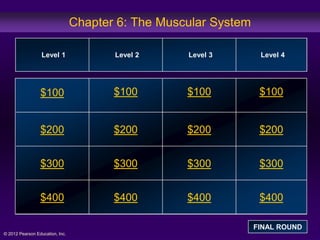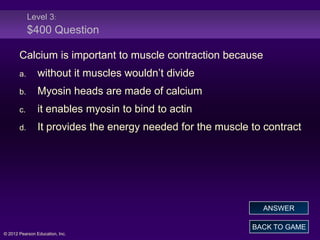Ch 6 Muscle Jeopardy Review Game
- 1. Chapter 6: The Muscular System Level 1 Level 2 Level 3 Level 4 $100 $100 $100 $100 $200 $200 $200 $200 $300 $300 $300 $300 $400 $400 $400 $400 FINAL ROUND ┬® 2012 Pearson Education, Inc.
- 2. Level 1: $100 Question A large, sheetlike tendon is a(an) a. tensor. b. ligament. c. synergist. d. aponeurosa. ANSWER BACK TO GAME ┬® 2012 Pearson Education, Inc.
- 3. Level 1: $100 Answer A large, sheetlike tendon is a(an) a. tensor. b. ligament. c. synergist. d. aponeurosa. BACK TO GAME ┬® 2012 Pearson Education, Inc.
- 4. Level 1: $200 Question The 3 types of muscle tissue are a. connective, actin, myosin b. aerobic, anaerobic, striated c. skeletal, voluntary, involuntary d. skeletal, smooth, cardiac ANSWER BACK TO GAME ┬® 2012 Pearson Education, Inc.
- 5. Level 1: $200 Answer The 3 types of muscle tissue are a. connective, actin, myosin b. aerobic, anaerobic, striated c. skeletal, voluntary, involuntary d. skeletal, smooth, cardiac BACK TO GAME ┬® 2012 Pearson Education, Inc.
- 6. Level 1: $300 Question The propagated (growing) action potential makes the sarcolemma permeable to this ion moving into the cell. a. Na+ b. ClŌłÆ c. Ca2+ d. K+ ANSWER BACK TO GAME ┬® 2012 Pearson Education, Inc.
- 7. Level 1: $300 Answer The propagated action potential makes the sarcolemma permeable to this ion moving into the cell. a. Na+ b. ClŌłÆ c. Ca2+ d. K+ BACK TO GAME ┬® 2012 Pearson Education, Inc.
- 8. Level 1: $400 Question When Na+ enters the sarcolemma of a muscle cell during an action potential, it stimulates ____ to be released from the sarcoplasmic reticulum. a. Ca+ b. K+ c. ATP d. Na+ ANSWER BACK TO GAME ┬® 2012 Pearson Education, Inc.
- 9. Level 1: $400 Answer When Na+ enters the sarcolemma of a muscle cell during an action potential, it stimulates ____ to be released from the sarcoplasmic reticulum. a. Ca+ b. K+ c. ATP d. Na+ BACK TO GAME ┬® 2012 Pearson Education, Inc.
- 10. Level 2: $100 Question Smooth muscle cells are a. voluntary b. striated c. involuntary d. multinucleate ANSWER BACK TO GAME ┬® 2012 Pearson Education, Inc.
- 11. Level 2: $100 Answer Smooth muscle cells are a. voluntary b. striated c. involuntary d. multinucleate BACK TO GAME ┬® 2012 Pearson Education, Inc.
- 12. Level 2: $200 Question Which of the following is NOT a function of the muscular system: a. production of movement b. maintenance of posture c. generation of heat d. hematopoiesis ANSWER BACK TO GAME ┬® 2012 Pearson Education, Inc.
- 13. Level 2: $200 Answer Which of the following is NOT a function of the muscular system: a. production of movement b. maintenance of posture c. generation of heat d. hematopoiesis BACK TO GAME ┬® 2012 Pearson Education, Inc.
- 14. Level 2: $300 Question The mechanical force of contraction is generated by: a. shortening of the thick filaments b. shortening of the thin filaments c. a sliding of thin filaments past thick ones d. the temporary disappearance of thin filaments ANSWER BACK TO GAME ┬® 2012 Pearson Education, Inc.
- 15. Level 2: $300 Answer The mechanical force of contraction is generated by: a. shortening of the thick filaments b. shortening of the thin filaments c. a sliding of thin filaments past thick ones d. the temporary disappearance of thin filaments BACK TO GAME ┬® 2012 Pearson Education, Inc.
- 16. Level 2: $400 Question Place these structures of the skeletal muscle in order from largest to smallest: 1. fascicle 2. muscle fiber (cell) 3. myosin filament 4. sarcomere a. 1, 2, 3, 4 c. 4, 3, 2, 1 b. 1, 2, 4, 3 d. 2, 1, 4, 3 ANSWER BACK TO GAME ┬® 2012 Pearson Education, Inc.
- 17. Level 2: $400 Answer Place these structures of the skeletal muscle in order from largest to smallest: 1. fascicle 2. muscle fiber (cell) 3. myosin filament 4. sarcomere a. 1, 2, 3, 4 c. 4, 3, 2, 1 b. 1, 2, 4, 3 d. 2, 1, 4, 3 BACK TO GAME ┬® 2012 Pearson Education, Inc.
- 18. Level 3: $100 Question The cell membrane of a muscle cell is known as a(n) a. Sarcoplasmic reticulum b. Myosin head c. Sarcolemma d. Fasicle ANSWER BACK TO GAME ┬® 2012 Pearson Education, Inc.
- 19. Level 3: $100 Answer The cell membrane of a muscle cell is known as a(n) Difference b/t a. Sarcoplasmic reticulum endomysium & sarcolemma? b. Myosin head c. Sarolemma d. Fasicle BACK TO GAME ┬® 2012 Pearson Education, Inc.
- 20. Level 3: $200 Question When the myosin heads link to the thin filaments they are called a. articulations. b. myofibrils. c. cross bridges. d. reticuli. ANSWER BACK TO GAME ┬® 2012 Pearson Education, Inc.
- 21. Level 3: $200 Answer When the myosin heads link to the thin filaments they are called a. articulations. b. myofibrils. c. cross bridges. d. reticuli. BACK TO GAME ┬® 2012 Pearson Education, Inc.
- 22. Level 3: $300 Question Acetylcholine is: a. an ion pump on the postsynaptic membrane b. a source of energy for muscle contraction c. a component of thick myofilaments d. a neurotransmitter that stimulates skeletal muscle ANSWER BACK TO GAME ┬® 2012 Pearson Education, Inc.
- 23. Level 3: $300 Answer Acetylcholine is: a. an ion pump on the postsynaptic membrane b. a source of energy for muscle contraction c. a component of thick myofilaments d. a neurotransmitter that stimulates skeletal muscle BACK TO GAME ┬® 2012 Pearson Education, Inc.
- 24. Level 3: $400 Question Calcium is important to muscle contraction because a. without it muscles wouldnŌĆÖt divide b. Myosin heads are made of calcium c. it enables myosin to bind to actin d. It provides the energy needed for the muscle to contract ANSWER BACK TO GAME ┬® 2012 Pearson Education, Inc.
- 25. Level 3: $400 Answer Calcium is important to muscle contraction because a. without it muscles wouldnŌĆÖt divide b. Myosin heads are made of calcium c. it enables myosin to bind to actin d. It provides the energy needed for the muscle to contract http://www.sci.sdsu.edu/movies/acti n_myosin.html BACK TO GAME ┬® 2012 Pearson Education, Inc.
- 26. Level 4: $100 Question Most of the energy provided for muscle contraction comes from a. anaerobic respiration. b. glycolysis. c. aerobic respiration. d. KrebŌĆÖs cycle. ANSWER BACK TO GAME ┬® 2012 Pearson Education, Inc.
- 27. Level 4: $100 Answer Most of the energy provided for muscle contraction comes from a. anaerobic respiration. b. glycolysis. c. aerobic respiration. d. KrebŌĆÖs cycle. BACK TO GAME ┬® 2012 Pearson Education, Inc.
- 28. Level 4: $200 Question This high-energy molecule is found in only muscle cells. a. ADP b. ATP c. Creatine phosphate d. Calmodulin ANSWER BACK TO GAME ┬® 2012 Pearson Education, Inc.
- 29. Level 4: $200 Answer This high-energy molecule is found in only muscle cells. a. ADP b. ATP c. Creatine phosphate d. Calmodulin BACK TO GAME ┬® 2012 Pearson Education, Inc.
- 30. Level 4: $300 Question Muscles that perform opposite actions to one another are termed __________. ANSWER BACK TO GAME ┬® 2012 Pearson Education, Inc.
- 31. Level 4: $300 Answer Muscles that perform opposite actions to one another are termed __________. Antagonists BACK TO GAME ┬® 2012 Pearson Education, Inc.
- 32. Level 4: $400 Question Explain the function of the endomysium, epimysium and perimysium ANSWER BACK TO GAME ┬® 2012 Pearson Education, Inc.
- 33. Level 4: $400 Answer Explain the function of the endomysium, epimysium and perimysium They are all connective tissues. Endomysium ŌĆō wraps individual muscle cells Epimysium ŌĆō wraps entire muscle Perimysium ŌĆō wraps fasicles BACK TO GAME ┬® 2012 Pearson Education, Inc.
- 34. FINAL ROUND Question Basically muscles contract because a. Myosin fibers get shorter b. actin fibers slide past myosin c. Muscle cells degrade and rebuild d. The sacroplasmic reticulum contracts ANSWER BACK TO GAME ┬® 2012 Pearson Education, Inc.
- 35. FINAL ROUND Answer Basically muscles contract because a. Myosin fibers get shorter b. actin fibers slide past myosin c. Muscle cells degrade and rebuild d. The sacroplasmic reticulum contracts http://faculty.massasoit.mass.edu/whanna/201/2 01_content/topicdir/muscle/muscle_media/muscl e_VD/page143/page143.html BACK TO GAME ┬® 2012 Pearson Education, Inc.


























































































